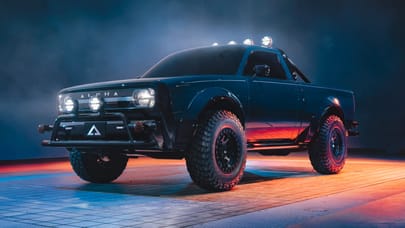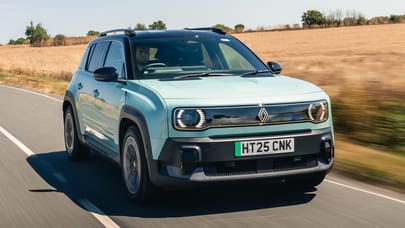

You know how shopping centres work? They have giant 'anchor stores' on the ends of their arms, which pushes footfall to the smaller shops between.
The Geneva show is the same. The major manufacturers' huge, glassy double-deck stands are ranged all around the periphery of the vast halls. Filling the middle of the floors are a chequerboard of dozens and dozens of smaller stands.
These are the homes of the small-volume makers, the optimistic new entrants, the specialists, the tuners and the coachbuilders. We've trawled them to bring you a cross-section of some of the most interesting left-field stuff this year.
Advertisement - Page continues below
ED Design is a large Italian design and engineering group no-one has ever heard of because most of its work is secret, ending up with other manufacturers' names on. At Geneva it pushed out its own side-project: an autonomous racing car.
But under the insect-like panels there's still room for a driver. ED's boss Mike Robinson explains that in a race series of identical autonomous cars "all the cars will win. And no-one will come to watch". But he wants ED to supply a field of such cars. So the idea is that he'll open-source the cars so that different teams can develop driving software.
Plus, the car's driver can work with the software to plan overtaking moves, and do the racecraft. But the driver won't be looking out through a windscreen - there's no glass.
Instead, the inside of the cockpit is lined with screens that show the outside view, free of pillar obstruction, and onto which can be overlaid huge amounts of head-up info to help the driver. Mind you, there's another reason the ED racer has no windows: so far it's just a solid clay model with no working guts.

From the dreamlike future to the eminently solid past. Brabus, known for its tuned-up and re-trimmed Mercedes, had three gorgeous classic Benzes on its stand. They're examples of how company's workshops rebuild to breathtaking beyond-new standard, re-set the odo to zero and offer them will full two-year warranty.
I'd always fancied one of these 280SE 3.5 four-seat cabrios. But at €495,000 (£360k) I'm having to walk.
Advertisement - Page continues below
Next up two beautifully rebodied, limited-edition Ferraris. The nicely rounded but punchy yellow-and-black waspish one is by Pininfarina, and named Sergio after the second generation to have headed the family firm, Sergio Pininfarina, who died three years ago. It's based on a 458, and they've made an edition of six. All sold.

Never mind, you can still have a re-bodied F12 by Touring Superleggera, called the Berlinetta Lusso. It's a classical shape very neatly done, with most panels in hand-beaten aluminium and the rest in carbon fibre. The first was commissioned by a Ferrari collector, and now a run of four more is to be made.

The Quant F is an astonishing looking concept for a four-seater, with its nasal gills, gullwing doors and Koenigsegg-like wraparound glazing. It's very well finished for a show car too.
That's not the big USP however. It's an electric car, but the electricity comes from what's dubbed a ‘nanoFlowcell'. Like other batteries, flowcells use electrolyte, but instead of charging and discharging a fixed qualtity, they pass the stuff as a liquid from external tanks (for the positive and negative) past the membrane. That's well-known physics.
Where nanoFlowcell begs to differ is in using a secret "ionic liquid". I ask about it but am told it's all secret and under patent. They say the car is zero-emission, but it wastes the liquid once it's been through the cells. A 500 litre fill-up is supposed to take it 500 miles, but that's a lot to spew out. And the liquid isn't, they tell me, water.
So how's that zero emission? And how will it solve our transport needs if there's no infrastructure for this "ionic liquid"? Loads of questions remain.
Company founder, the dandyish Nunzio la Vecchia, and his one partner have funded the whole project - car, company, labs with 100-plus employees from their own pockets. But there's to be an IPO soon, so I guess they'll have to shine some more light on the tech.

Finally another futuristic saloon concept. ItalDesign is now part of the VW Group, working as a semi-detached ideas incubator. The Gea is meant as a luxury saloon for an era when - two key trends here - cars are electrically powered and can drive themselves.
It's vast: those wheels are 26-inchers. When it's being driven, the LED head- and tail-lights shine their normal colours, but in autonomous mode they turn partially blue.
When the artist formerly known as driver is in the back seat, the Gea has three modes. One that's all businesslike, with all the comms tools you need. Need to relax after all this shifting your virtual currency around? A 'wellness' mode turns the place into a gym, with resistance machine handles and pedals sprouting from the doors and floor.
Then there's 'dream' mode, where you recline near-horizontal as the windows tint darkly and star-and-galaxy images are projected around the cabin. If you fancy a movie, it's played on a screen that takes up the whole headliner...
Advertisement - Page continues below
More from Top Gear
Trending this week
- Car Review
BMW 1 Series
- Top Gear's Top 9
Nine dreadful bits of 'homeware' made by carmakers







